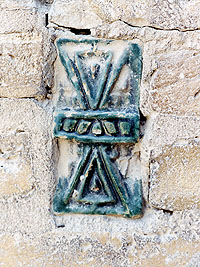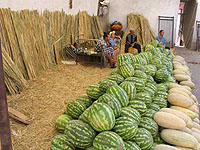 |
|
Uzbekistan - Namangan Province |
||||
|
Established: 1967 The province is located in the east of the country, in northern part of the Ferghana Valley. There are 11 rural districts in the province - Kosonsoy, Mingbulok, Namangan, Norin, Pop, Turakurghon, Uichi, Uchkurgon, Chortok, Chust, and Yangikurghon; 8 towns - Namangan, Koson, Pop, Turakurghon, Uchkurghon, Chortok, Chust, and Khaqqulobod; 12 town-type villages, and 99 villages. City of Namangan is the administrative center of the province (432 km away from Tashkent, 382,6 thousand people). Agriculture: cotton, horticulture, viticulture, silkworm breeding, vegetables, and livestock farming. Branches of industry such as machinery, audio and video (electric appliances), chemical and food processing industries are well developed. More than 30 joint ventures, 3,402 small businesses and 249 cooperatives are now operating in the province. In 1992 a crude oil deposit was discovered in Mingbulok District. Agriculture is mainly concentrated on cotton production. The province produces nearly 10 percent of the total cotton harvest of the country. Fruit, grapes, vegetable cultivation and livestock farming are also well developed. There are 135 collective farms and 3077 private farms. The automobile is the main means of transportation. The total length of automobile roads is 5,400 kilometers, 4,300 km of which is covered with asphalt. The total length of railroads is 140 km. There are well-developed airline routes in the province between cities in the province. There are 646 schools, gymnasiums, lyceums, special musical and sporting schools, universities, 4 theaters, 576 libraries, 307 clubs, 180 movie theaters, 2 museums, and 10 cultural centers in the province. More than hundred healthcare establishments and 6 sanatoriums provide medical services. Namangan is the second most populated city in the Ferghana Valley. It is also known as the city of gardens. The city was first mentioned as a village settlement in Zakhiriddin Muhammad Bobur's manuscript "Boburnoma" in the 15th century. Modern Namangan is the center of light and food industry. There are major textile enterprises that produce about 15 percent of the country's total textile goods. The outskirts of the city are astonishingly beautiful. The Chortok Sanatorium is located in Chortoksoy Valley, a river flowing down from mountains. There are wonderful parks with pine and oak trees in the Chotkol Mountains. The historic settlement Chust is located not far from to Namangan. From ancient times Chust has been famous as the land of gifted painters, craftsmen and artists. National metal artwork such as knives, dishes and agricultural tools are made in Chust. |


